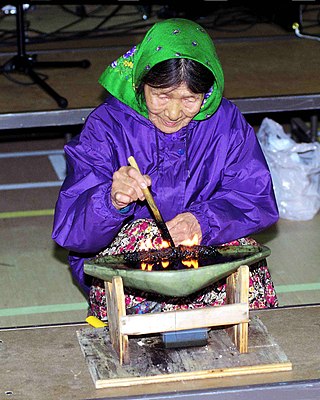1917 abolition
| | This section needs expansion. You can help by adding to it. (October 2015) |
In 1917, the law was abolished and the possibility to give birth anonymously was criminalized. [9]
The Infanticide Act (Swedish : Barnamordsplakatet), often referred to as "Infanticide act of Gustav III" (Gustav III:s barnamordsplakat) after its instigator Gustav III of Sweden, was a historical Swedish law, which was introduced in 1778 and in effect until 1917, with alterations in 1856. [1]
The law was introduced in order to prevent infanticides, the killings of newborn children outside of marriage, and granted mothers both the right and the means for an anonymous birth. Its 1856 amendment however restricted this to a mere confidential birth, where the midwife was ordered to keep the mother's name in a sealed envelope to allow the grown-up child to request undisclosure of its biological ancestry. [2]
The problem of infanticide was since long acknowledged to be affected by the social stigma condemning unmarried mothers: previously, a reform of 1741 abolished the Public humiliation punishment of Uppenbar kyrkoplikt for unmarried mothers to prevent infanticide, [3] and the Infanticide Act of 1778 was a continuation of this work.
It allowed for mothers to give birth anonymously, to spare them social embarrassment and difficulty. It also forbade the midwife to ask for the name of the father, which they had previously been obliged to do. The mother was allowed to leave her home area and give birth in an area where she was unknown without having to answer any questions about her identity. [4] The birth certificate should only include the date of the birth and the name of the child, while its mother should be registered as "Mother Unknown". [5]
The child would then be placed in an orphanage. However, if the father was known, he could bring the child from the orphanage, midwife or the home where the "anonymous" woman had given birth to his home as a foster child. The mother might then join him, officially as a nurse to care for the baby, and very often the couple got married. The child was then a legitimate child to the man and had his name. The word "stepmother" disappeared from most official papers, as a married woman taking care of the children in her household would be recognized legally as their mother.
In 1856, the law was amended. The midwife was now ordered to advise the mother at a secret birth to write down her name and home address in a sealed envelope. The mother was then to have the vicar in the town where she gave birth to put his seal on it and keep it safe. [6] The paper could also be kept at the birth registration office. [7] The function of the paper was to enable the mother to claim her child if she should wish it after having left it after birth. They could also be opened on request by the child.
The law from 1856 states:
| | This section needs expansion. You can help by adding to it. (October 2015) |
In 1917, the law was abolished and the possibility to give birth anonymously was criminalized. [9]
Infanticide is the intentional killing of infants or offspring. Infanticide was a widespread practice throughout human history that was mainly used to dispose of unwanted children, its main purpose being the prevention of resources being spent on weak or disabled offspring. Unwanted infants were usually abandoned to die of exposure, but in some societies they were deliberately killed. Infanticide is generally illegal, but in some places the practice is tolerated, or the prohibition is not strictly enforced.

Midwifery is the health science and health profession that deals with pregnancy, childbirth, and the postpartum period, in addition to the sexual and reproductive health of women throughout their lives. In many countries, midwifery is a medical profession. A professional in midwifery is known as a midwife.
Abortion in Sweden was first legislated by the Abortion Act of 1938. This stated that an abortion could be legally performed in Sweden upon medical, humanitarian, or eugenical grounds. That is, if the pregnancy constituted a serious threat to the woman's life, if she had been impregnated by rape, or if there was a considerable chance that any serious condition might be inherited by her child, she could request an abortion. The law was later augmented in 1946 to include socio-medical grounds and again in 1963 to include the risk of serious fetal damage. A committee investigated whether these conditions were met in each individual case and, as a result of this prolonged process, abortion was often not granted until the middle of the second trimester. As such, a new law was created in 1974, stating that the choice of an abortion is entirely up to the woman until the end of the 18th week.
Closed adoption is a process by which an infant is adopted by another family, and the record of the biological parent(s) is kept sealed. Often, the biological father is not recorded—even on the original birth certificate. An adoption of an older child who already knows their biological parent(s) cannot be made closed or secret. This used to be the most traditional and popular type of adoption, peaking in the decades of the post-World War II Baby Scoop Era. It still exists today, but it exists alongside the practice of open adoption. The sealed records effectively prevent the adoptee and the biological parents from finding, or even knowing anything about each other. However, the emergence of non-profit organizations and private companies to assist individuals with their sealed records has been effective in helping people who want to connect with biological relatives to do so.

Marie-Louise Lachapelle was a French midwife, head of obstetrics at the Hôtel-Dieu, the oldest hospital in Paris. She published textbooks about women's bodies, gynecology, and obstetrics. She argued against forceps deliveries and wrote Pratique des accouchements, long a standard obstetric text, which promoted natural deliveries. Lachapelle is generally regarded as the mother of modern obstetrics.
Neonaticide is the deliberate act of a parent murdering their own child during the first 24 hours of life. As a noun, the word "neonaticide" may also refer to anyone who practices or who has practiced this.

Countess Christina Augusta Löwenhielm, was a Swedish noblewoman and courtier. She is known for her love affair with the later Charles XIII of Sweden. She is also famous in history as one of "the three graces" of the Gustavian age; three ladies-in-waiting immortalized in the poem Gracernas döpelse by Johan Henric Kellgren, and known profiles of the epoch.
Psychiatric disorders of childbirth, as opposed to those of pregnancy or the postpartum period, are psychiatric complications that develop during or immediately following childbirth. Despite modern obstetrics and pain control, these disorders are still observed. Most often, psychiatric disorders of childbirth present as delirium, stupor, rage, acts of desperation, or neonaticide. These psychiatric complications are rarely seen in patients under modern medical supervision. However, care disparities between Europe, North America, Australia, Japan, and other countries with advanced medical care and the rest of the world persist. The wealthiest nations represent 10 million births each year out of the world's total of 135 million. These nations have a maternal mortality rate (MMR) of 6–20/100,000. Poorer nations with high birth rates can have an MMR more than 100 times higher. In Africa, India & South East Asia, as well as Latin America, these complications of parturition may still be as prevalent as they have been throughout human history.

The Inuit are indigenous people who live in the Arctic and subarctic regions of North America. The ancestors of the present-day Inuit are culturally related to Iñupiat and Yupik, and the Aleut, who live in the Aleutian Islands of Siberia and Alaska. The word "Eskimo" has been used to encompass the Inuit and Yupik, and other indigenous Alaskan and Siberian peoples, but this usage is in decline.
Childbirth practices in Benin are strongly influenced by the sociopolitical structure of the West African country.

Louise (Bourgeois) Boursier (1563–1636) was royal midwife at the court of King Henry IV of France and the first female author in that country to publish a medical text.[1] Largely self-taught, she delivered babies for and offered obstetrical and gynecological services to Parisian women of all social classes before coming to serve Queen Marie de Medicis in 1601.[2] Bourgeois successfully delivered Louis XIII, King of France (1601) and his five royal siblings: Elizabeth, Queen of Spain (1602); Christine Marie, Duchess of Savoy (1607); Nicolas Henri, Duke of Orléans (1607); Gaston, Duke of Orléans (1608); and Henrietta Maria, Queen of England, Queen of Scots, and Queen of Ireland (1609). In 1609, Bourgeois published the first of three successive volumes on obstetrics: Observations diverses sur la sterilité, perte de fruict, foecondite, accouchements et maladies des femmes et enfants nouveaux naiz / Amplement traictees et heureusement praticquees par L. Bourgeois dite Boursier. Subsequent volumes were published in 1617 and 1626, also in Paris.[3]

Karin Svensdotter was a 17th-century Swedish woman who claimed to have had children with the King of the fairies.

Stanisława Leszczyńska was a Polish midwife who was incarcerated at the Auschwitz concentration camp during World War II, where she delivered over 3,000 children. Her beatification process was opened in 2015.

Hanna Albertina Rydh was a Swedish archaeologist and politician for the Liberal People's Party. She served as a Member of Parliament in the Riksdag from 1943 to 1944 and was the 3rd President of the International Alliance of Women from 1946 to 1952.

The status and rights of Women in Sweden has changed several times throughout the history of Sweden. These changes have been affected by the culture, religion and laws of Sweden, as well as social discourses like the strong feminist movement.
China has a history of female infanticide which spans 2,000 years. When Christian missionaries arrived in China in the late sixteenth century, they witnessed newborns being thrown into rivers or onto rubbish piles. In the seventeenth century Matteo Ricci documented that the practice occurred in several of China's provinces and said that the primary reason for the practice was poverty. The practice continued into the 19th century and declined precipitously during the Communist era, but has reemerged as an issue since the introduction of the one-child policy in the early 1980s. The 2020 census showed a male-to-female ratio of 105.07 to 100 for mainland China, a record low since the People's Republic of China began conducting censuses. Every year in China and India alone, there are close to two million instances of some form of female infanticide.
Peder Jönsson, was a Swedish hunter and fisherman from Söderköping, who was executed for having confessed to sexual intercourse with a Sjörå. Though there are other cases of the same kind in 17th-century Sweden, his is the only case where the sentence is confirmed to have been executed.
An anonymous birth is a birth where the mother gives birth to a child without disclosing her identity, or where her identity remains unregistered. In many countries, anonymous births have been legalized for centuries in order to prevent formerly frequent killings of newborn children, particularly outside of marriage.
In a confidential birth, the mother provides her identity to authorities, but requires that her identity not be disclosed by the authorities. In many countries, confidential births have been legalized for centuries in order to prevent formerly frequent killings of newborn children, particularly outside of marriage.
Amanda Teresia Waesterberg (1842–1918) was a Swedish composer.